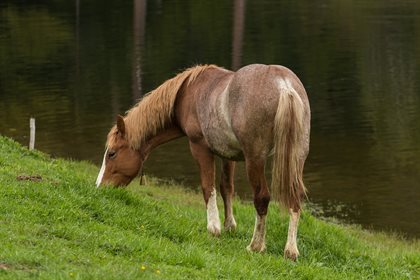
With EHV-1 still presenting a threat throughout North America and Europe, Palm Beach Equine Clinic’s Dr Peter Heidmann answered some of the world’s questions during his takeover of the Noelle Floyd Instagram page.
1. Equine Herpesvirus (EHV) can be present in any area where there are horses.
EHV can be found in horses in every country around the world. The virus can have varying consequences and not every horse may be symptomatic. The duration of immunity, the capability to shed viral particles, and whether it continues to carry the virus are all variables unique to the individual horse.
2. There are multiple strains of EHV that lead to varying health defects.
Most horses, by two years old, have been exposed to EHV. Nearly every horse over five years old has had EHV in a mild respiratory form, in which they have likely suffered from symptoms such as a runny nose or cough. The disease becomes gravely serious when there is a neurological form of EHV-1 that is spreading rapidly among horses.
Over the last century, the primary focus of EHV disease control was related to reproduction. EHV was a major cause of infectious abortions in mares. Since the advent of effective vaccines that protect against EHV abortions, the concern has shifted to the rare but serious occurrences of neurologic disease caused by EHV-1.
Certain strains of EHV can have more propensity to cause neurological disease.
3. Vaccination is key.
There are currently no genetic explanations regarding whether a particular horse may be more likely to contract EHV-1. However, when a horse is stressed, whether it be from shipping, competing, or other causes, its immune system is more susceptible to illness. EHV-1 can live in the central nervous system, and during times of stress when endogenous corticoids are produced, the virus can start to replicate.
This causes the horse to shed viral particles into the environment and explains why there are outbreaks of the disease. It does not take much for a stressed horse to start shedding viral particles into the environment and infecting non-stressed horses nearby.
Vaccinations can help horses generate additional antibodies and minimize the spread of disease. The vaccines available today are effective at preventing the respiratory and reproductive strains of EHV, but are not effective for the neurologic strain. It is just as important as ever to vaccinate because vaccines help to limit the spread of virus by decreasing the shedding of viral particles from each individual horse.
4. Surveillance is crucial to preventing a serious outbreak in the United States.
Due to the recent outbreak in Europe, medical surveillance has increased. There are now extra layers of protection in the process of importing horses. Imported horses have always been quarantined, but now horses are also receiving a nasal swab to look for the presence of EHV-1 in their nasal passages. There have been cases of EHV-1 in the U.S. recently. However, there is no evidence that these EHV-1 cases are related to the major outbreak in Europe, partially thanks to our increased level of surveillance on horses being brought into the country.
5. The handling of horses with fevers shifts dramatically when cases have been identified locally.
Veterinarians have significantly shifted how show horses with any symptoms are being handled. If a horse had presented with a fever or runny nose prior to the European EHV-1 outbreak in early 2021, it would typically have been treated by its own veterinarian and left to return to full health. What is happening now is that each horse with a fever becomes a possible candidate for being the index case of EHV-1. This changes veterinarians’ responsibilities everywhere because of the potential for the disease to spread among the population in respective local areas. Horses with fevers must therefore be strictly quarantined and tested.
The fastest and most accurate test in the world for diagnosing EHV-1 is a PCR test, which looks for the DNA of the infecting organism. The horse will test positive if it is actively shedding organisms. The biggest downside is that it typically takes 24 hours to produce results. Therefore, horses who have been tested are put under strict isolation until the test results come back. Often, by the time test results are ready, the horse’s symptoms have ceased. Yet that is the level of scrutiny necessary to prevent a serious outbreak.
6. There are clusters of the disease reported all over the United States, although they are unrelated to the neurological strain of EHV-1 outbreak in Europe.
While this is routine from a veterinarian’s perspective, it is still serious and certainly worth our attention. A few isolated cases reported in the U.S. this March have been found to be due to the neurotropic form of the disease and some have been non-neurotropic. The concern is warranted, but cases are highly localized, mainly in areas with large equine populations. We see the disease cropping up because the virus may already be dormant in their bodies. To minimize the likelihood of outbreaks on the individual farm level, have a vaccination program with your veterinarian and if necessary take temperatures of horses twice daily to catch any viral infection early.
To read more expert articles from world-leading equine vets at the Palm Beach Equine Clinic, click here.
Source: Palm Beach Equine Clinic
READ THE LATEST NEWS ARTICLES HERE
https://www.equestrianlife.com.au/articles/6-facts-about-EHV-1-from-equine-veterinarian-Dr-Peter-Heidmann

